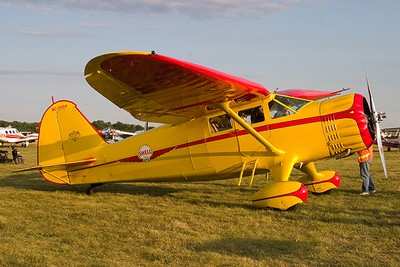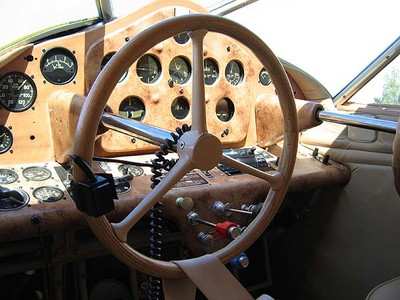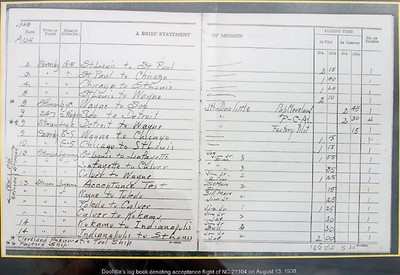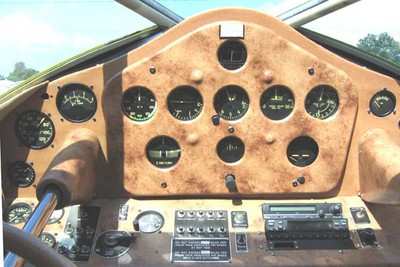A Look At Doolittle's Shell Oil Co. "Gullwing" Beauty
by ANN Correspondent Dave Ziegler
Tom Dinndorf of Baudette, MN owns more than an immaculately
restored 1938 Stinson SR-10 Reliant -- he owns a piece of aviation
history. The "gull-wing" Stinson he bought in 1971, built for the
Shell Oil Company and delivered on August 12, 1938, was flown by
none other than aviation great Jimmy Doolittle himself.

"Doolittle, who was a Vice President for Shell Oil, flew to
Wayne, Michigan where the airplane was built," explained Dinndorf,
"and then flew an acceptance flight." After taking delivery,
Doolittle flew this particular Stinson, NC21104, more than 100
times on various business trips between 1938 and 1940.
Stinson manufactured the Reliant as the SR-10 from 1938 until
the beginning of World War II. During the war, Stinson produced 500
military versions of the aircraft for use as the AT-19 (US) and
V-77 (British Royal Navy), which were used primarily as instrument
trainers. About 350 of these military models were reintroduced into
the civilian market after the war.
"I bought this project in 1971 with the idea that I was going to
restore it," Dinndorf explained, but after making little progress
he decided to find help. A well-restored Stinson SR-8 he had seen
led him to Rod Roy of Roy Aero Service, Grand Marais, MN who he
eventually hired to finish the project.

Roy, who worked on the aircraft for four years, utilized the
entire original framework and built a new metal cowling which was
missing when the aircraft was acquired by Dindorff. He completed
restoration just prior to EAA AirVenture Oshkosh 2005, where the
aircraft won Reserve Grand Champion. A month later the Stinson was
named Grand Champion by the Blakesburg Antique Airplane
Association.
Inside and out, NC21104 is pristine. Large control wheels, which
may seem more at home on a luxury yacht, grace the Stinson's
elegant simulated wood-grain panel and fit in well with the fine
leather seating.

According to Dinndorf, he and Doolittle met at Oshkosh in the
70s, where Doolittle confirmed the aircraft's authenticity.
Dinndorf later learned that Shell had four Stinson's, with
Doolittle's being the last, hence the old Stinson/new Stinson
nomenclature in the logs he displays with the aircraft.

Dinndorf shared some of his knowledge on Doolittle's early
career, explaining that the historic aviator made more
contributions to aviation than most people realize. "People know
him for bombing Tokyo, and people might know something about his
air racing career, but Jimmy did a lot of things for the Army Air
Corp immediately after World War I and throughout the '20s. He won
the Schneider Trophy, the Bendix Trophy, the Thompson Trophy, and
then he retired from air racing in '32 and that's when he worked
for Shell Oil.
"While he was in the army, the army recognized him as a very
bright guy, so they sent him to MIT where he earned a Ph.D. in
aeronautics -- the first one ever -- and he was Phi Beta Kappa at
MIT, so he was a very bright guy. And one of his biographies is
called Calculated Risk, which are two words that describe him. He
was a risk taker, he was a daredevil, but he was also a Ph.D.
engineer so everything was calculated."

Doolittle was also the first pilot to fly solely on instruments
when in September 1922 he flew a DeHavilland DH-4 equipped with
early navigational instruments from Pablo Beach, FL to San Diego,
CA.
While working for Shell Oil, Doolittle -- who saw World War II
looming -- influenced the company to ramp up production of 100
octane fuel, something most oil companies were unwilling to produce
in great supply on speculation. "At that time, the engine people
wouldn't build engines because there was no fuel, and the fuel
people wouldn't make fuel because there were no engines."
 ANN's Daily Aero-Linx (04.15.24)
ANN's Daily Aero-Linx (04.15.24) Classic Aero-TV: 'No Other Options' -- The Israeli Air Force's Danny Shapira
Classic Aero-TV: 'No Other Options' -- The Israeli Air Force's Danny Shapira Aero-News: Quote of the Day (04.15.24)
Aero-News: Quote of the Day (04.15.24) Airborne 04.16.24: RV Update, Affordable Flying Expo, Diamond Lil
Airborne 04.16.24: RV Update, Affordable Flying Expo, Diamond Lil ANN's Daily Aero-Term (04.16.24): Chart Supplement US
ANN's Daily Aero-Term (04.16.24): Chart Supplement US







